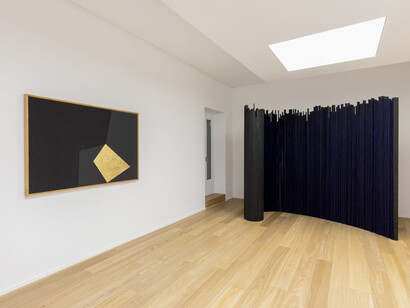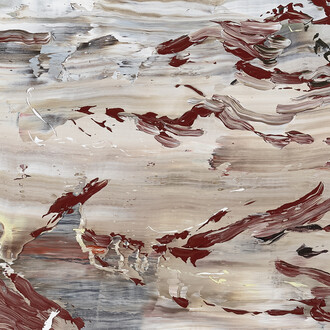Mazzoleni opens its new Milan exhibition space on Tuesday 30 September 2025 with the exhibition Nero x nero (Black x black), dedicated to works by Alberto Burri and Nunzio, curated by Bruno Corà, art critic and President of the Burri Foundation in Città di Castello.
Uniting two of the most significant voices in Italian art, the exhibition reflects Mazzoleni’s long-standing ties with both artists. Burri's works have accompanied the gallery's nearly forty years history through major projects, including solo exhibitions in Turin (2004, 2012) and London (2015). Nunzio has been central to the London programme with two solo shows, the first curated by Kenneth Baker in 2019, and more recently, in 2023 with a presentation of previously unseen drawings. Both were also brought together in Burri, Kounellis, Nunzio. Ethic of the artwork, curated by Corà in London in 2021.
The exhibition underscores Mazzoleni's dual vocation: on one hand, the commitment to promoting the great masters of post-war Italy, and on the other, fostering dialogue with contemporary artists. Here, Burri and Nunzio meet around the theme of black.
In the critical text accompanying the exhibition, Corà recalls that the first work installed by Burri at Palazzo Albizzini was Catrame 1 (1948). In the following years, black became a constant presence in his work, "like the cosmic darkness of an unknown dimension to venture into, Burri's black is always an elaboration of spaced matter, where form and an equilibrium shared with the 'caecitas' of poets still reign." Black is also the result of a transformative action of fire, as within the Plastiche series, in which Burri pushes the potential of matter to its limits. Choosing the alchemical nature of "...flame as an infernal brush", as Brandi defined it in his famous 1963 essay, Burri paints with fire and exploits its entire potential, simultaneously destructive and generative.
For Nunzio, fire is equally transformative. “A purifying bath that changes the state of matter and evokes its fossil, the darkness,” he explains. From his earliest works, shadow, night and black have marked his research. Burnt wood and lead, his chosen materials, open a dialectic between permanence and change: wood as night and shadow, lead as light, mutable and reflective. As Corà writes, “What renders Nunzio’s work dialectical with Burri’s is the attention to the qualification of form as an ethical entity that confronts and withdraws from time.”
Alongside wood, Nunzio also uses lead, a material that introduces a further level of tension and complexity. If wood represents shadow and night, lead instead connects to light, to its capacity to continuously transform the perception of the work. The surface of the metal, unstable and changing, reacts differently depending on the incidence of light, making each sculpture an organism in becoming. This dialectic between wood and lead, between combustion and metallic surface, constructs a sculptural language that unites the rigour of matter with its poetic transformation.
Among Alberto Burri's works, Nero cretto (1970) and Nero e oro (1993) are particularly significant. The latter, with its black acrylic and gold leaf on cellotex, draws inspiration from Ravenna’s mosaic tradition and revisits the pure abstraction of Burri’s early work. Nunzio's sculpture Avvoltoio (2019), demonstrates his ability to transcend post-war Italian sculptural tradition, while a newly conceived work for the Milan space expands his exploration of fire and material metamorphosis. Both sculptures are suspended between light and shadow, marked by scars of combustion and the vitality of transformation.












